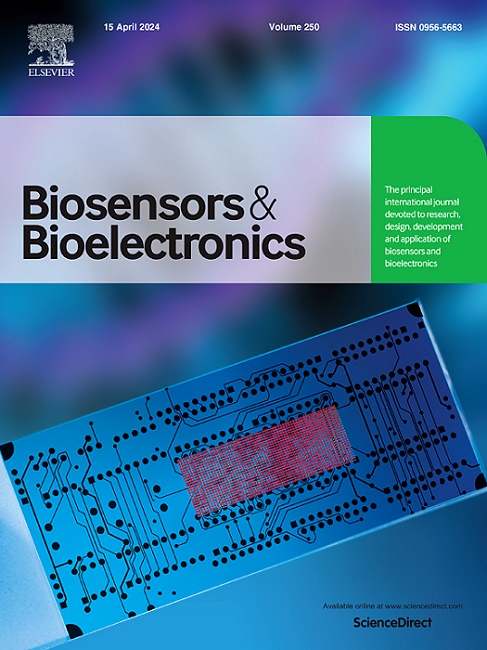Label-free detection of heme in electroactive microbes using a probe-typed optical fiber SPR sensor
IF 10.5
1区 生物学
Q1 BIOPHYSICS
引用次数: 0
Abstract
Heme, as a key cytochrome ligand in electroactive microbes, enables sensitive label-free detection for studying extracellular electron transfer-mediated corrosion processes. Developing a reliable, label-free, and high-performance sensor for heme detection is crucial to investigate extracellular electron transfer-mediated microbial corrosion. Herein, we present a probe-typed fiber-optic surface plasmon resonance (SPR) heme sensor based on biomolecular recognition between heme and its transport regulator (FhtR) protein. When heme molecule contacts the sensor surface, FhtR can coordinate with the iron ion of heme and stably embed the hydrophobic porphyrin ring of heme into its hydrophobic pocket through van der Waals forces, thereby changing the refractive index of the sensing surface and causing a shift in the SPR spectrum. Therefore, the concentration of heme can be measured by monitoring the wavelength shift. Experimental results demonstrated that the sensitivity of the sensor was 698.1 nm/(mg/mL) in the range of 0–0.06 mg/mL heme, and the wavelength shift reached 48.95 nm in the range of 0–0.24 mg/mL heme, with a detection limit of 0.9 μg/mL and a response time of 18 min. Rapid determination of trace heme concentration was realized. In the real sample detection experiment of Shewanella oneidensis MR-1, it is verified that the sensor still has good recognition ability for samples diluted 1000 times. To explore the universality of the sensor, the real blood environment is used as the detection environment, which proves the unique innovation and applicability of the sensor in complex environments. In addition, the sensor exhibited excellent selectivity against different humoral molecules and metal ions. It also demonstrated excellent stability against the variation in pH (7.5–8.5), temperature (23.25–51.46 °C), and pressure (0.1–3.6 MPa).
利用探针型光纤SPR传感器检测电活性微生物中的血红素
血红素是电活性微生物中关键的细胞色素配体,可用于研究细胞外电子转移介导的腐蚀过程。开发一种可靠的、无标签的、高性能的血红素检测传感器对于研究细胞外电子转移介导的微生物腐蚀至关重要。在此,我们提出了一种基于血红素及其运输调节因子(FhtR)蛋白之间生物分子识别的探针型光纤表面等离子体共振(SPR)血红素传感器。当血红素分子接触传感器表面时,FhtR可以与血红素的铁离子配合,通过范德华力将血红素的疏水卟啉环稳定嵌入到其疏水口袋中,从而改变传感表面的折射率,引起SPR光谱的移位。因此,可以通过监测波长位移来测量血红素的浓度。实验结果表明,该传感器在0 ~ 0.06 mg/mL血红素范围内灵敏度为698.1 nm/(mg/mL),在0 ~ 0.24 mg/mL血红素范围内波长位移达48.95 nm,检出限为0.9 μg/mL,响应时间为18 min,实现了痕量血红素浓度的快速测定。在真实样品检测实验中,验证了该传感器对稀释1000倍的样品仍具有良好的识别能力。为了探索传感器的通用性,采用真实血液环境作为检测环境,证明了传感器在复杂环境中的独特创新和适用性。此外,该传感器对不同的体液分子和金属离子具有优异的选择性。在pH(7.5-8.5)、温度(23.25-51.46°C)、压力(0.1-3.6 MPa)等条件下均表现出良好的稳定性。
本文章由计算机程序翻译,如有差异,请以英文原文为准。
求助全文
约1分钟内获得全文
求助全文
来源期刊

Biosensors and Bioelectronics
工程技术-电化学
CiteScore
20.80
自引率
7.10%
发文量
1006
审稿时长
29 days
期刊介绍:
Biosensors & Bioelectronics, along with its open access companion journal Biosensors & Bioelectronics: X, is the leading international publication in the field of biosensors and bioelectronics. It covers research, design, development, and application of biosensors, which are analytical devices incorporating biological materials with physicochemical transducers. These devices, including sensors, DNA chips, electronic noses, and lab-on-a-chip, produce digital signals proportional to specific analytes. Examples include immunosensors and enzyme-based biosensors, applied in various fields such as medicine, environmental monitoring, and food industry. The journal also focuses on molecular and supramolecular structures for enhancing device performance.
 求助内容:
求助内容: 应助结果提醒方式:
应助结果提醒方式:


